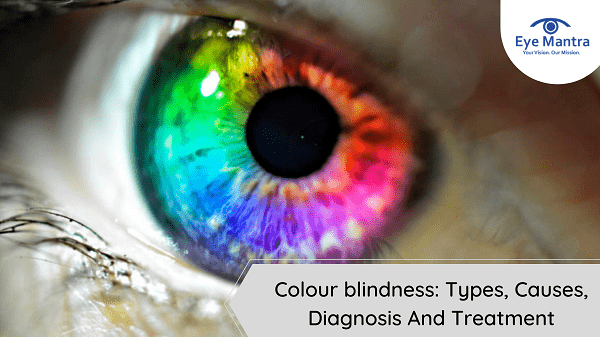A person affected by color blindness will have difficulty seeing the colors red, blue, green, or a mixture of those colors. In extremely rare cases, an individual might not be ready to identify any color in the least. Colour blindness is additionally referred to as a “color vision problem”. A color vision problem can make an individual’s life very difficult because it is extremely hard for them to find out. Individuals with this problem can also not be ready to pursue certain careers. However, children and adults with this problem can adapt and catch up on their problem of not having the ability to differentiate colors.
Contents
The Genetics Of Colour blindness
Colour blindness is essentially determined by a gene on the X chromosome. This suggests that ladies need two copies of the gene to truly be colorblind but they will be carriers with no symptoms if they only have one copy, whereas men are going to be colorblind if their single X chromosome contains the gene. As a result, around eight percent of men are colorblind, compared to but one percent of girls.
How chromatic vision Works
There are two sorts of light-sensitive cells in our retinas: rods and cones. Rods enable us to see in low-light conditions, while cones enable us to see colors. Our color vision is trichromatic, meaning we’ve cones that are specifically sensitive to long (red), medium (green), and short (blue) wavelengths of sunshine. Colour blindness is what happens when one or more of those sorts of cones don’t work the way they ought to.
Types Of Colour blindness
The most common type of color blindness is red/green. Because red and green are opposite colors, you’ll be red/green colorblind whether it’s the green cones that aren’t working (deuteranomaly) or the red cones (protanomaly). The result’s about an equivalent either way: colors with red or green in them appear duller or yellowish-brown.
Much rarer is blue/yellow color blindness (tritanopia), which happens when the blue cones are those that don’t work properly.
Even rarer than red/green and blue/yellow color blindness is monochromacy or complete color blindness. People with “monochromacy” can only see in grey. They tend to be extremely sensitive to light. Because cones are what give us sharp detail in our vision, monochromacy also can mean that vision is going to be fuzzy overall.
Glasses To Correct Colour Blindness?
With color, the grey problem is detected as soon as possible. Children with color vision problems have difficulty in learning, writing, and reading. Also, having color vision problems may hinder an individual from following particular careers where it’s mandatory to inform the colors apart. It is recommended that children between ages 3 and 5 have regular eye exams. Children before starting their school life should undergo vision screening a minimum of once.
Causes of Colour blindness
Colour blindness may be usually a genetic (hereditary) condition (you are born with it). Red/green and blue color blindness is typically passed down from your parents. The gene which is liable for the condition is carried on the X chromosome and this is often the rationale why more men are affected than women.
There are estimated to be over 250 million color-blind people worldwide. The overwhelming majority of individuals with a color vision deficiency have inherited their condition from their mother, who is generally a ‘carrier’ but not color blind herself. Some people also acquire the condition as a result of long-standing diseases like diabetes, MS, some liver diseases, and most eye diseases.
The effects of color vision deficiency are often mild, moderate, or severe depending upon the defect. If you’ve got inherited color blindness your condition will stay an equivalent throughout your life – it won’t get any better or worse.
There are three sorts of cone cells and every type features a different sensitivity to light wavelengths. One sort of cone perceives blue light, another perceives green and therefore the third perceives red. Once you check out an object, light enters your eye and stimulates the cone cells. Your brain then interprets the signals from the cone’s cells so that you’ll see the color of the thing. The red, green, and blue cones all work together allowing you to ascertain the entire spectrum of colors. For instance, when the red and blue cones are simulated in a certain way you’ll see the color purple.
The exact physical causes of color blindness are still being researched but it’s believed that color blindness is typically caused by faulty cones but sometimes by a fault within the pathway from the cone to the brain.
People with normal color vision have all three sorts of cone/pathways working correctly but color blindness occurs when one or more of the cone types are faulty. For instance, if the red cone is faulty you won’t be ready to see colors containing red clearly. Most people with color blindness can’t distinguish between colors such as red and green.
Diagnosis, Treatment, and Impact of Colour Deficiency
Diagnosis of color deficiency is extremely straightforward during a traditional eye exam. This is often done by using colored plates with dots in various patterns to spell out letters, numbers, lines, or shapes. These color plates use specific colors which are difficult to be recognized by color deficient individuals. As a result, these individuals have trouble identifying the numbers on the plate, except for a color normal individual, this may be very easy.
To know more about it, you can easily visit our website Eyemantra. If you are looking for other services like cataract surgery, Retina surgery or Ocuploplasty you can simply ring at +91-9711115191. Even you can simply mail us on [email protected].
Related Links



